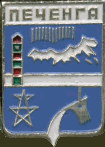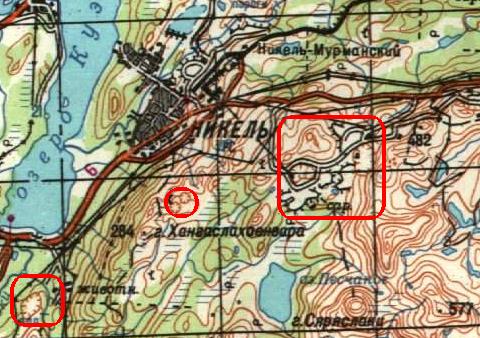
~
Nikel-Pechenga
~


some open pits are visible on the map
Pechenga is a town near the Norwegian border. Just a little to the south lays the settlement of Nikel. It would not surprise anybody that a settlement with such a name has something to do with nickel mining. The site was discovered in 1912 by Russian geologists and further explored by the Finnish in 1921.
geology
The deposits of Nikel-Pechenga belong geologically to the Pechenga belt. The
Pechenga belt consists of volcanosedimentary rocks. The volcanic activity here
is contributed to the same riftsystem as the Imandra Varzuga belt. The Pechenga belt can be divided into a southern
and northern part, separated by the Poritash faultzone. The southern part of the belt consists mainly of highly
metamorphosed rocks. The southern, metamorphic zone is only partially related to
the northern zone. Some rocks bear similar ages, others are younger (late
Karelian complex, vs early Karelian complex of the northern zone).
The northern part is built up by four consecutive cycles of sedimentary and
volcanic deposition. Each cycle starts with a thin layer of sediment, followed
by a think layer of volcanic rocks. The four cycles where deposited between
2.4Ga and 1.9Ga ago. In these 500Ma a 8.5km thick formation was formed. Four
cycles of both volcanic and sedimentary origin makes eight formations. The eight
formations are Neverskrukk sedimentary, Ahmlahti volcanic, Kuetsjarvi
sedimentary, Kuetsjarvi volcanic, Kolasjoki sedimentary, Kolasjoki volcanic,
Pilgujarvi sedimentry and Pilgujarvi volcanic.
These eight formations are described in more detail by Foster. Unless something nice is discovered they seem to have little importance for us rockhounds. Ores can only be found in the sedimentary phase of the uppermost (latest) cycle, the sedimentary Pilgujarvi formation. Neither the sediment, nor the extrusive rocks bear very interesting mineralogy, apart from pyrite and graphite in the sediments.. The volcanism was accompanied by many gabbro-wehrlite intrusions. In total there are over 300 (!) gabbro-wehrlite intrusions, mostly in the Zdanov and Lammas tuffaceous sedimentary layers, the underlaying Zapolyarny formation of volcanic rocks. All of the economic deposits are found in the western most part of the northern part, the so called Western Rift Graben.
The intrusions show different degrees of differentiation, where the most differentiated ones usually bear more mineralogy. The undifferentiated intrusions consist of clinopyroxenites and are usually up to 15 meters in thickness. The differentiated intrusions are bigger and contain rocks like pyroxene-olivinite, clinopyroxenite, gabbro, diorite, and wehrlite.
Some of the better known intrusions are: Pilgujärvi, Kierzhipori, Kaula, Kotselvaara, Kammikivi, Mirona, Onki, Ortoaivi, Pilgujarvi, Raisoaivi, Semiletka and north Soukerjoki. All these localities are named after local mountains. There are in total 25 economic intrusions, 68 are sub economic and 113 have no interesting mineralogy at all. [3]
The Pilgujärvi intrusion is connected with the zapolyarninskoye deposit and the Zhdanovskoye deposit. Apart from the intrusions, there where also pyroclastic and lava flows which deposited nickel ores, the so called ferropicritic flows. The ores are mines through both open pits and underground mining.
The Karik'javr deposit has rich in PGM mineras, compared to the other intrusions of the region. [6]
mineralogy
A major difference with for instance the comparable Monchegorsk intrusions
is the fact that most mineralogy in the Nikel district are formed AFTER the
intrusion by hydrothermal activity.
Almandine Argentopentlandite Azurite Bornite Calcite Chalcopyrite Chromite
Clinochrysotile Cobaltite Covellite Cubanite Diopside Dolomite Ferro-Axinite
Galena Gersdorffite Graphite Ilmenite Mackinawite Magnetite Malachite Marcasite
Maucherite Millerite Morenosite Nickeline Nickel-skutterudite Parkerite
Pentlandite Pyrite Pyrrhotite Quartz Retgersite Siderite Sperrylite Sphalerite
Sylvanite Talc Talnakhite Tremolite Troilite Valleriite Vermiculite Violarite
mentioned for Karik'javr [6]:
Altaite Bismuth Froodite Gold Hessite Hollingworthite Irarsite Michenerite
Osarsite
References
[1] Sulphide Cu-Ni deposits of the Pechenga ore field, by V.F. Smolkin et al.
[2] Gmelin-Krauts Handbuch der anorganischen Chemie, Nickel
[3] The Pechenga Ore Deposits: Russia, by J.G Foster, 2003, Geodiscovery Group, Australia
[4] Ore Deposits of the USSR, V.I. Smirnov, 1977, Vol II, p7 - 20
[5] The Composition and mode of formation of the Pechenga nickel deposits,
Kola peninsula, northwestern Russia
Barnes et al, CanMin Vol39, pp447-471 (2001)
[6] Kolesar & Tvrdy, 2006, Zarenschätze, Bode Verlag